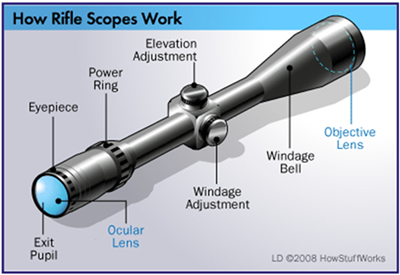FAQ's - Questions and Answers

Click on the blue question line to view the answer:
Eye Relief refers to the distance between the ocular lens (see schematic) and where the image comes into focus and the entire field of view (no black) can be seen. Proper eye relief is important for safe, comfortable shooting. For rifle scopes, a minimum of 3 inches is best.
In General :
- Our rifle scopes have 3 - 4 inches of eye relief
- Pistol / Scout Scopes have approx. 18 inches of eye relief
- Tactical Scopes (AR Style) have 4 - 6 inches of eye relief
- Red/Green/Blue Dots with no magnification have unlimited eye relief (can be placed at any distance, although closer is better)
- Our Mosin - Nagant scopes have 10 - 11 inches of eye relief which is the distance most mounts require
When looking through an optic, the Field of View is the area between the left and right right edges of the image. Field of View is measured in feet or angular degrees. One degree equals 52.5 feet.
Variable power scopes will express Field of View as a range, from the lowest magnification to the highest.
A wide Field of View has advantages when following fast - moving game or scanning dense habitats. Traditional deer hunting scopes will be in the order of 3 - 9 power or 3 - 12 power. If the game is in open ground, higher magnification can be used.
For bench rest target shooting, Field of View is not an issue.
This is the size of the beam of light that exits the Ocular (see schematic) and enters the user's eyes. A larger Exit Pupil will deliver a brighter image, especially in low light conditions.
A larger Objective lens will deliver a brighter images, especially under low light conditions. Deer and nocturnal animals (Hogs, Armadillos, Coyotes, etc.) are better seen with a larger Objective lens. Consider illumination for non-game hunting. (Check rules for this)
A larger Objective Lens is heavier, more costly, and may need to be mounted higher on your rifle.
Our scopes have superior lens clarity and are fully multi-coated. Take a look at Chinese scopes, especially the edges. The clearer the glass, the brighter the image.
As the glass quality increases, the weight increases. Avoid large objective, light - weight scopes.
Most of the scopes TheOpticsPlace.com stocks are Variable - Power scopes. Variable power scopes are convenient to use either in the field or target shooting. IJK does make fixed power scopes - they can always be ordered.
Example:
A 3 (three) power scope enlarges the image 3 times normal. A target that is one inch high will appear as 3 inches high when looking through a scope at 3 power.
A 12 (twelve) power scope enlarges the image 12 times normal. A target that is one inch high (using just your eye) will appear as 12 inches high when looking through a scope at 12 power.
A 3 - 12 x scope will, at it's lowest magnification (3) is a 3 power scope. This scope will gradually increase in magnification from 3 to 12 power by turning the power ring. You can easily zoom from 3 power to 12 power on this scope.
We offer a wide range of scopes that start at 1 (one) power (no magnification) up to 40 (forty) power.
Factors such as your vision (good or bad), target distance, target size, lighting conditions, scope cost, speed of target should be considered.
Turrets are used to adjust the bullet's point of impact down range, and is marked in MOA. Turrets come in covered or exposed styles. For an explanation of MOA (Minute of Angle) click here.
This is the adjustment on the end of the scope. It is marked with approximate yardages to aid in initial setting and should be matched to the targets distance. The final focus setting should be checked by moving shooters head back and forth slightly, watching for any shift of the reticle on the target (parallax). If a shift is detected, turn the front slightly until a shift is no longer observed. Once this focus is correctly set, shooting errors due to parallax will be eliminated. For an explanation on Parallax, click here.
This scope type has the same purpose as the Adjustable Objective scope, eliminating the need to reach out to the end of the scope to make adjustments. Reaching forward on an AO scope may put you out of position for shooting. For an explanation on Parallax, click here.
Future